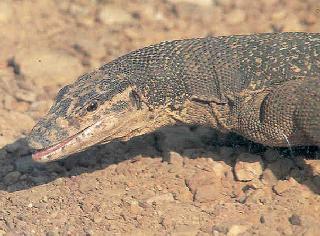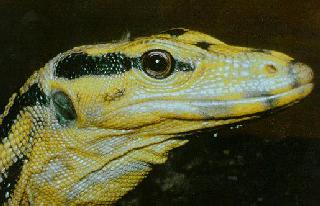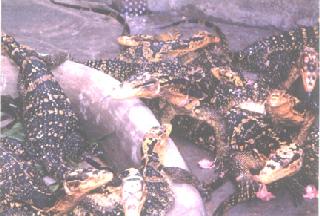Philippine Wildlife
Varanus - The Monitor Lizard
The "Water Monitor", Varanus sp.,
is the largest lizard found in the Philippines, growing up to 2-1/2 meters,
and is a cousin of the Komodo Dragon. It is locally known as "bayawak"
and
is sometimes called a "chicken lizard" because it may feed on chicken eggs
or chicks. Monitors are opportunistic feeders and scavengers and eat a
variety of small animals, insects, fish, molluscs and carrion. As their
name implies, they prefer living near fresh or salt- water bodies and are
good swimmers.
Varanid lizards are widely distributed throughout
the Philippines with at least two species: V. olivaceus (Gray's
Monitor) and V. salvator, (Water Monitor) with several subspecies.
Although fairly common, monitors are at risk due to habitat destruction
and unregulated hunting.
According to a varanid expert, Eric Pesci:
The top photo is of the nominate Varanus salvator salvator
or water monitor. The second (middle) photo is of the majestic Mindanao
Water Monitor - Varanus salvator cumingi - reproductively
isolated to Mindanao and Basilan. This lizard is so beautiful and
so close to extinction yet no one seems to care. It has been hunted
for skins and to this day - even with a government ban on reptile exports
- the lizard is still obtained for leather manufacturers in Asia and Europe.
This lizard inhabits only Mindanao and a few have been found on Basilan
in the Sulu. I have reports of increased rodent and insect populations
which this lizard previously kept in check. This lizard is afforded
no CITES protection because it is recognized as a sub-species of the nominate
water monitor. Having worked with this lizard for many years, I can
say that a re-elevation to species status - Varanus cumingi cumingi
- is not a bad idea although I need to complete additional tests before
I start petitioning for species elevation.
The interesting thing about the monitor lizards in the Philippines is
that there are species of monitors living on one island that are totally
different from those on the neighboring island. Panay/Negros/Cebu
have V. s. nuchalis. Mindoro/Luzon have V. s. marmoratus.
Masbate/Ticao have a dark form V. s. nuchalis. Samar/Leyte/Bohol
have a dark form V. s. cumingi . Luzon has V. olivaceous.
Mindanao has the king - V. s. cumingi. All these island are so close
and monitors can easily swim and populate/colonize/mix but they don't.
The endemism is awe inspring yet so fragile.

Varanus salvator salvator
|

Varanus salvator cumingi
Photo courtesy Daniel Bennett daniel@glossop.co.uk
|

Monitors captured for their skins.
Photo courtesy Eric Pesci |
Eric Pesci is developing a conservation program for varanids. For more
information about monitor lizards, you can contact him at: varanus@phoenix.net
Get involved with varanid conservation with Mampam Conservation: http://www.mampam.com/

